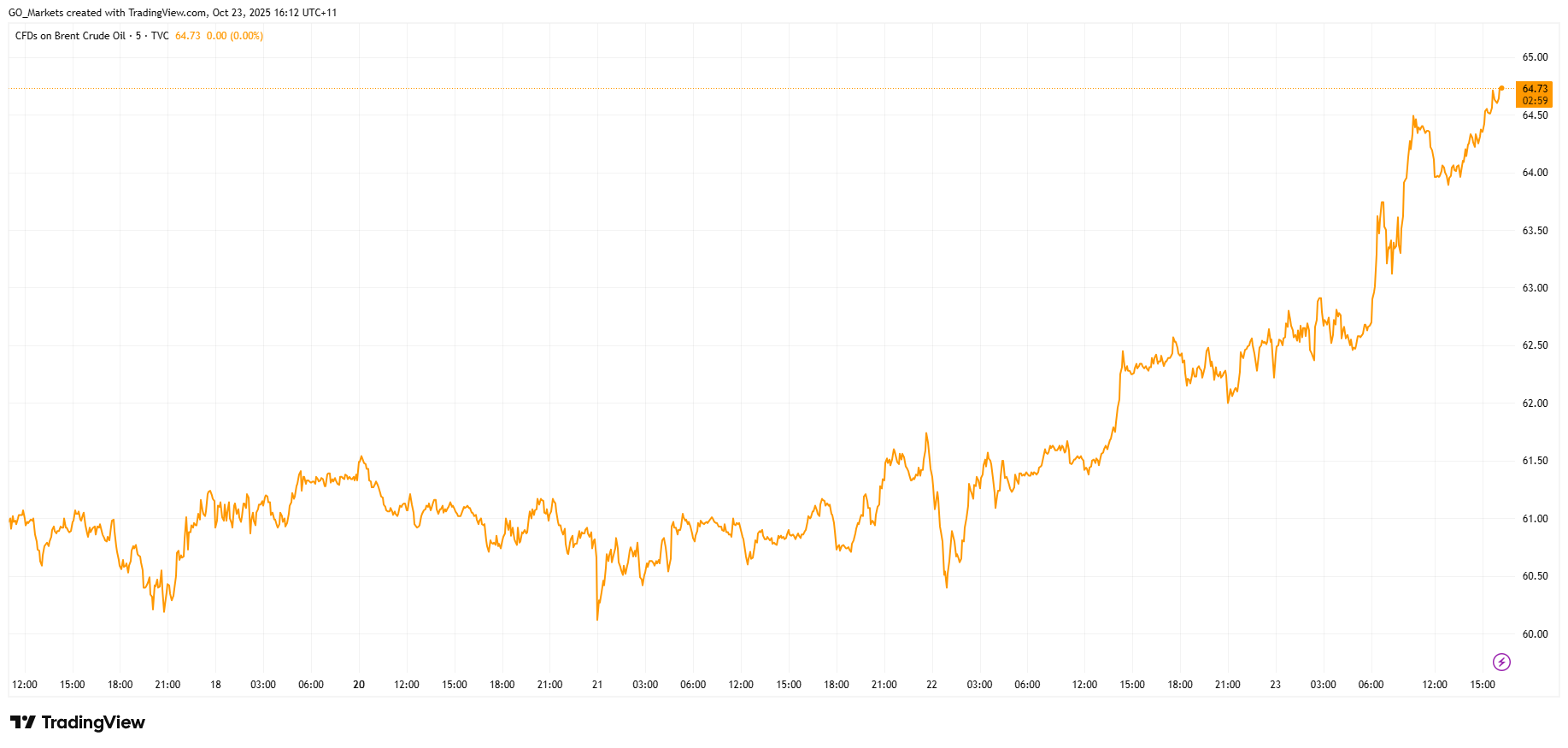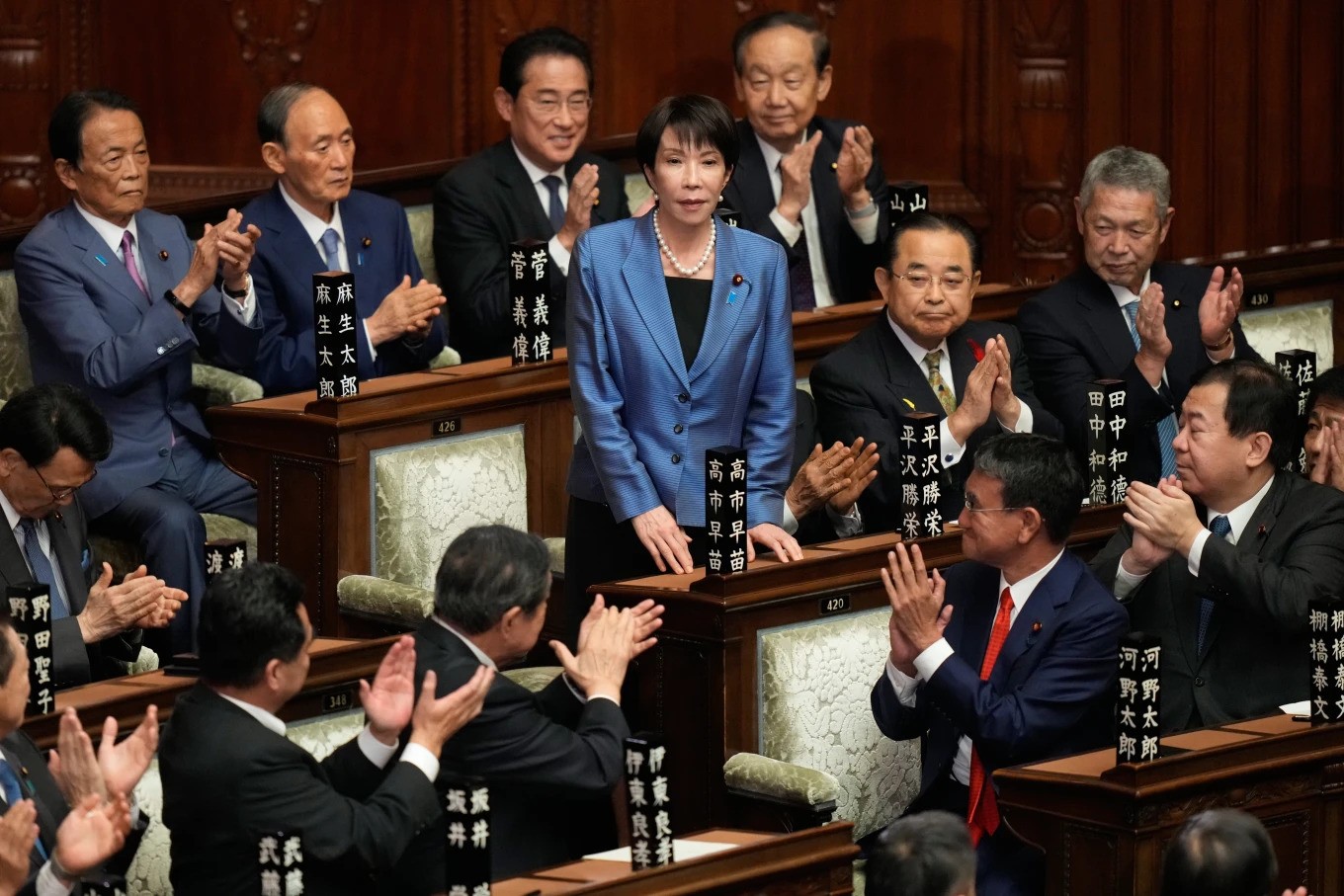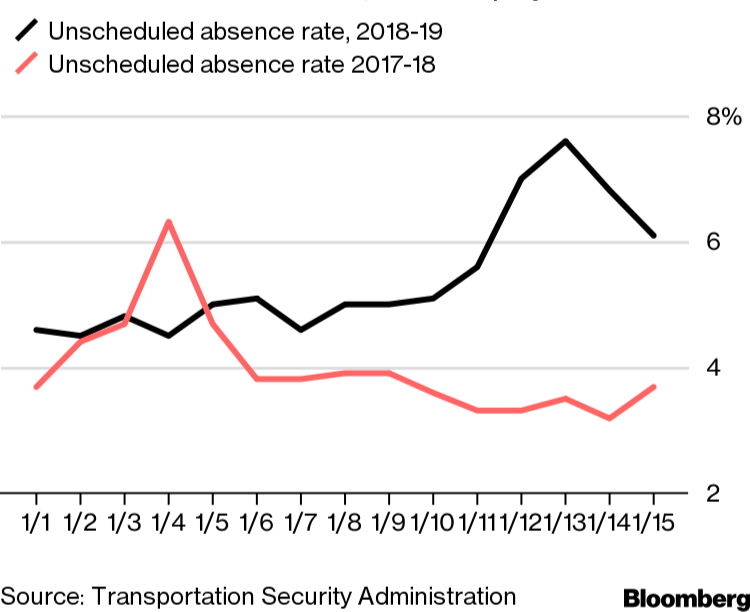Market news & insights
Stay ahead of the markets with expert insights, news, and technical analysis to guide your trading decisions.

New U.S. Sanctions on Russia as Putin Conducts Nuclear Tests
The U.S. has imposed new sanctions on Russia's two largest oil companies, Rosneft and Lukoil, after planned peace talks between Trump and Putin collapsed on Wednesday.
Oil prices spiked 3% after the announcement, with Brent crude hitting $64 per barrel.

The targeted companies are among the world's largest energy exporters, collectively shipping about three million barrels of oil daily and accounting for nearly half of Russian production.
The sanctions build on recent European measures, as the UK targeted the same companies last week and the EU approved its own sanctions package on Wednesday.
In a show of force coinciding with the new sanctions, Putin supervised strategic nuclear exercises on Wednesday involving intercontinental ballistic missile launches from land and submarine platforms.
While the Kremlin emphasised these were routine drills, the highly coincidental timing is notable.
For markets, the key question now is whether secondary sanctions will follow, and if Trump’s enforcement remains strict. Traders will watch closely for any TACO signals that see Trump ease pressure in an attempt to restart negotiations.
Historic PM Wasting No Time on Celebrations
Sanae Takaichi made history this week as Japan's first female Prime Minister. The 64-year-old conservative leader, dubbed the "Iron Lady,” is already rolling out an aggressive policy agenda that could reshape Japan's economic and geopolitical position.
Her first major move is an economic stimulus package expected to exceed US $92 billion. The package includes abolishing the provisional gasoline tax and raising the tax-free income threshold from ¥1.03 million ($6,800), moves designed to put more money in consumers' pockets and battle inflation.

Her next move will come when Trump arrives in Tokyo next week, as the Japanese government is finalising a purchase package including Ford F-150 pickup trucks, US soybeans, and liquefied natural gas as sweeteners for trade talks.
Takaichi has campaigned on being a champion for expansionary fiscal policy, monetary easing, and heavy government investment in strategic sectors, including AI, semiconductors, biotechnology, and defence.
Critical Workers to Miss First Paycheck Due to Shutdown
The U.S. government shutdown is on the verge of creating a crisis for aviation safety, with 60,000 workers set to miss their first full paycheck this week.
These essential workers, who earn an average of $40,000 annually, already saw shortened paychecks last week. By Thursday, many will receive pay stubs showing zero compensation for the coming period, forcing impossible choices between basic necessities and reporting to work.
During the last extended shutdown, TSA sick-call rates tripled by Day 31, causing major delays at checkpoints and reduced air traffic in major hubs like New York — disruptions which are directly attributed to pressuring the end of the previous shutdown.

The National Air Traffic Controllers Association warns that similar pressures are building, with many workers soon to be facing a decision between attending their shift or putting food on the table.


Trading terms glossary A - B - C - D - E - F - G - H - I - J - K - L - M - N - O - P - Q - R - S - T - U - V - W - X - Y - Z - Q Quantitative easing An economic monetary policy intended to lower interest rates and increase money supply can be defined as Quantitative easing (QE). It saw an increase in profile and use after the 2008 financial crash and subsequent recession. Quote currency The second currency listed in a forex pair is termed as the quote currency.
It is also known as the counter currency. Quote The price at which an asset was last traded, or the price at which it can be currently bought or sold is defined as Quote


Trading terms glossary A - B - C - D - E - F - G - H - I - J - K - L - M - N - O - P - Q - R - S - T - U - V - W - X - Y - Z - O OCO (one cancels the other) OCO allows many orders to be placed at once. Whichever order is filled first will cancel the other automatically. OCO can be used to close an existing position or take advantage of market volatility.
Learn more about OCO Off book trades An "off-book" trade refers to trading shares outside of an exchange or regulated body. Off-book traders are usually executed via the over-the-counter (OTC) market, and made directly between two parties. Offer The term "offer" describes when one trader expresses an intention to buy a financial instrument or asset from another trader.
On exchange On exchange refers to a trade is taking place directly on an order book. On-balance volume (OBV) On-balance volume is a method of technical analysis where traders make predictions about an asset's future price movements based on its previous trading volume. OBV is regularly used in shares trading as volume has a large influence how a share price moves.
OPEC (Organisation of the Petroleum Exporting Countries) OPEC was founded in 1960 by Saudi Arabia, Iraq, Iran and Kuwait, Venezuela. Other countries that have since joined OPEC since include the United Arab Emirates, Algeria, Libya, Nigeria, Gabon, Angola, Equatorial Guinea, the Republic of the Congo and Ecuador. Learn more about OPEC Open (Market) The market "open" can refer to the daily opening of an exchange Open (order/position) An open order refers to an outstanding trading order/position that has not yet been filled/closed.
When a trade is executed, or a position closed, the profits and losses a are realised and the trade is no longer open. Option Options are a type of derivative specifically linked to an underlying asset. The Buyer of an option has the choice of whether or not to receive futures relating to an asset at a predetermined price, volume and expiry date.
Order An "order" is a request sent to a broker or trading platform instructing them to execute a particular trade. OTC trade (Over the Counter) An OTC trade is an agreement between two parties, not executed through an exchange. This allows increased flexibility compared to trading on the market, as contractual terms can be negotiated directly between the two parties.
Overexposure Overexposure refers to a trader taking on too much risk. A typical instance of this is when a trader invests too much capital in a single position or market; putting the trader in the position where an unfavorable movement of a single instrument can result in dramatic losses.


Trading terms glossary A - B - C - D - E - F - G - H - I - J - K - L - M - N - O - P - Q - R - S - T - U - V - W - X - Y - Z - P Price-to-earnings ratio (P/E) A company's P/E ratio is calculated by dividing the company’s market value per share by its earnings per share, and is a method for measuring a company’s value. Learn more about P/E ratios Learn more about P/E red flags Parent company Parent company refers to the entity which has a majority or controlling interest in another company, giving it the right to control the subsidiary’s operations. Pip A 'pip' is a measurement of movement in Forex trading; it is the smallest amount that a currency can change.
Pip value The pip value is the value attributed to a single pip move in a Forex (FX) trade. Purchasing managers index (PMI) PMI is an indicator of the health of a particular sector within an economy. Learn more about PMI Portfolio (Investment portfolio) Portfolio refers to the collection of assets held by a trader or trading entity, this can include shares, commodities, bonds, derivatives etc.
Position "Position" refers to an open trade, held by a trader, that is able to incur a profit or loss. Once a trade has been closer or canceled, the trader no longer holds that position. The actual profit or loss of a trade is not realised until the position has been closed.
Position Sizing Learn more about Position Sizing. Power of attorney (POA) Power of attorney gives another person or entity legal authority to act on your behalf. In trading, this means access to financial resources, trading accounts, the ability to open or close trading positions etc.
If POA is given to a legal entity, representatives within that entity authorized to act on your behalf will be listed specifically. Profit and loss (P&L) A profit and loss statement is a financial report summarizing a company’s gross revenue, expenses and profit. It provides traders and investors with a snapshot of how well a company is operating and it's potential to generate profit.
Pullback A pullback is a temporary dip an asset’s otherwise current trend. Not to be confused with a reversal, which is a longer term switch in an assets (previously) trending direction. Put Option A 'Put Options' is a contract giving a trader the right, but not the obligation, to sell a specific amount of an underlying contract, at a specific price, at a specific time.


Trading terms glossary A - B - C - D - E - F - G - H - I - J - K - L - M - N - O - P - Q - R - S - T - U - V - W - X - Y - Z - N Net change Net change refers to the difference between the closing price of the current trading session and the closing price of the previous trading session. This can be positive or negative, and simply represents whether a market is up or down compared to the previous day. Net income Net income is the total amount of profit made by an organization after all expenses, depreciation, amortization, interest, taxes etc. are deducted from it's gross income.
NIKKEI The NIKKEI index is the leading 225 stocks traded on Tokyo's Stock Exchange. Non-current assets Non-current assets are company’s long-term investments of which the full value will not be realized during the current accounting year, such as land holdings. Non-farm payrolls Non-farm payrolls gives monthly statistics describing number of people who are employed in construction, manufacturing and goods companies in the US.
Also referred to as NFP's. Learn more about Non-farm payrolls


Trading terms glossary A - B - C - D - E - F - G - H - I - J - K - L - M - N - O - P - Q - R - S - T - U - V - W - X - Y - Z - M Macro-based A trading strategy driven by macroeconomic factors. Maintenance margin Also known as the "variation margin", the maintenance margin is the amount of funds that must be available to keep a margin trade open. Margin call A margin call is when a broker requests an increase maintenance margin from a trader, in order to keep a leveraged trade open.
A margin call occurs when the percentage of an investor’s equity in falls below the broker’s required amount; this occurs after a position decreases significantly enough in value. Margin calls are charged to limit exposure to the participants, and mitigate risk to the broker. Margin Margin is the amount of funds required to open and maintain a leveraged position. e.g. a $500,000 position leveraged at 500:1 would required $1,000 in funds from the trader.
Margin deposit A margin deposit is the amount a trader needs to put up in order to open a leveraged position. This can also be referred to as the initial margin, or simply as the deposit Market capitalisation A companies market capitalisation is the total market value of the company’s shares on the market. Market capitalisation, or "market cap", is simple way for investors to gauge a company’s size, which can factor into their investment strategy.
Market data Market data refers to live streaming of trade-related data. This information can include market volume, price, bid and ask quotes and more. Marketing data is available on virtually all markets including commodities, shares, indices, FX etc.
Learn more about Market data releases Market maker A market maker is an trader that buys and sells large amounts of a particular asset in order to facilitate liquidity. A maker can institution or individual. Market order A market order is an instruction to a broker from the trader to execute a trade immediately at the current best available price.
This can be a 'buy' or 'sell'. Merger A merger is when two or more companies combine to become a single larger entity. This typically has significant financial implications and effect on the value of the participating companies stock value.
A promising merger will usually resulting in an increase in share prices. Learn more about Mergers MetaTrader MetaTrader is an popular online trading platform used for to trade a wide variety of instruments. MetaTrader 4 and Metatrader 5 versions are available with different tools and tradable assets.
Monte Carlo "Monte Carlo" refers to a method of measuring risk by developing a modelling and predicting future investment prices. This is then used to predict the worst-case loss scenario of an investment. Moving average convergence/divergence The MACD (moving average convergence/divergence) is a technical indicator which aims to identify changes in a share price's momentum.
The MACD helps traders identify possible opportunities around support and resistance levels by collecting data from different moving averages. Learn more about the Moving Average Convergence/Divergence oscillator (MACD). Moving average Often abbreviated to "MA", the moving average is a common indicator in technical analysis, used to examine price movements while reducing the impact of random spikes in an assets price.
Learn more about Moving Averages Multilateral trading facilities MTFs offer investment firms and traders an alternative to traditional exchanges. MTFs typically allow trade of a wider variety markets and equity products, including assets which may not have an official market. Multiplier effect Multiplier effect describes the impact that changes in monetary supply can have on economic activity.
When an government (or potentially company or individual) spends significant money it has a trickle-down effect the businesses and the economy which can have a much wider impact than the initial action.


Trading terms glossary A - B - C - D - E - F - G - H - I - J - K - L - M - N - O - P - Q - R - S - T - U - V - W - X - Y - Z - Kiwi "The Kiwi" is a slang name for New Zealand's Dollar. Key currency Key currencies are stable currencies that don't vary too much, which can be globally used to set exchange rates and support international trade. Examples of key currencies include the U.S. dollar, the British pound, the Euro, the Japanese yen, the Canadian dollar or the Swiss franc.

